How to Make a Subway Map with John Tauranac
Hear from an author and map designer who has been creating maps of the NYC subway, officially and unofficially, for over forty years!



At Untapped New York, we are no strangers to the secret beauty of the NYC subway system. Throughout the more than 470 stations you’ll find fascinating works of art that span the entire history of the transit system, from the construction of the very first stops to today. While many contemporary mosaic works are massive in size and hard to miss, there are many more subtle pieces that you might pass on your commute every day and never notice. Here, we explore those often overlooked pieces hiding in plain sight. Next time you’re taking public transportation, be sure to take a peek at these hidden subway art installations.
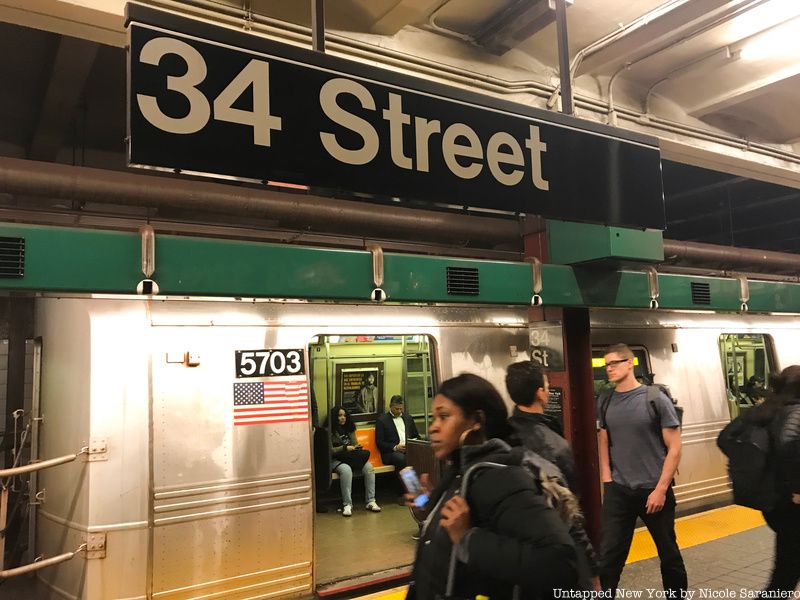
The 34th Street-Herald Square N/R train platforms have a secret pair of musical instruments. The green metal bars, easily mistaken for subway infrastructure, are part of an installation called Reach New York, An Urban Musical Instrument. What looks like air ducts are actually speakers, and the holes have motion sensors in them. If you reach up and put a hand in front of one of the holes, a musical note will play.
The unusual installation was created by artist Christopher Janney in 1996. It was installed to inspire interactions between strangers waiting for their trains. Riders can compose a spontaneous song with those waiting across the tracks on the other platform. See this and more of the installations mentioned in this list on our upcoming underground art walking tour!
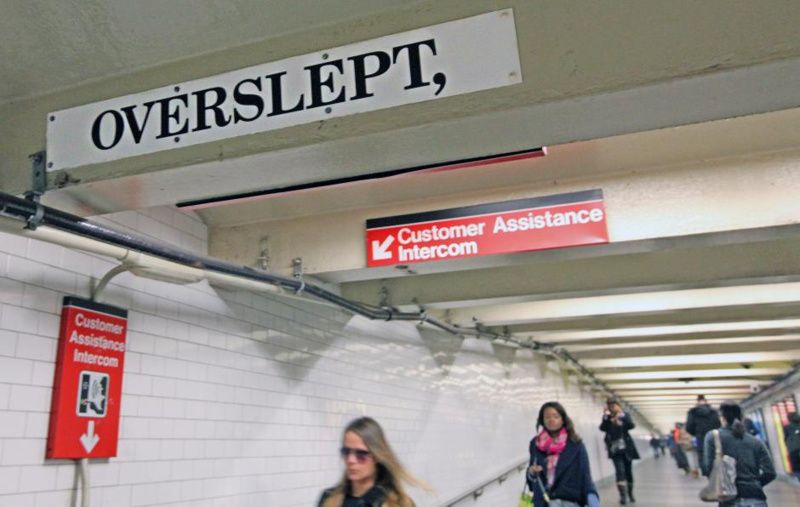
Norman B Colp wrote a poem titled “The Commuter’s Lament/A Close Shave,” inspired by the iconic Burma Shave ads of the 1920s. Those ads consisted of a series of signs displayed across the United States. The artwork was originally only supposed to be a temporary installation, yet the pieces still stand today in the transfer corridor from 42 Street-Port Authority Bus Terminal to Time Square-42nd Street.
The poem reads: “Overslept, so tired, if late, get fired. Why bother? Why the pain? Just go home, do it again.” These lines can be seen mounted overhead on every fifth beam in the corridor. The signs are not meant as a cruel joke, but instead to display the artist’s empathy for the commuters. Colp recalls that in his time commuting, he frequently barely made it to work on time.
Located in an abandoned Brooklyn subway station, Masstransiscope is an animated mural created by Bill Brand in 1980. This public artwork consists of a 300-foot-long painting, made of reflective material and installed on the tunnel walls of the subway. The special enclosure has hundreds of narrow slits on the front side near the train and the mural on the far side. Viewers see the piece through the slits and it appears to be animated by a stop-motion effect. The mural was restored in 2012 and can be seen by riding the Q train from the DeKalb station towards Manhattan, looking out the window of the side you entered the train. The mural is easily missed so keep an eye out!
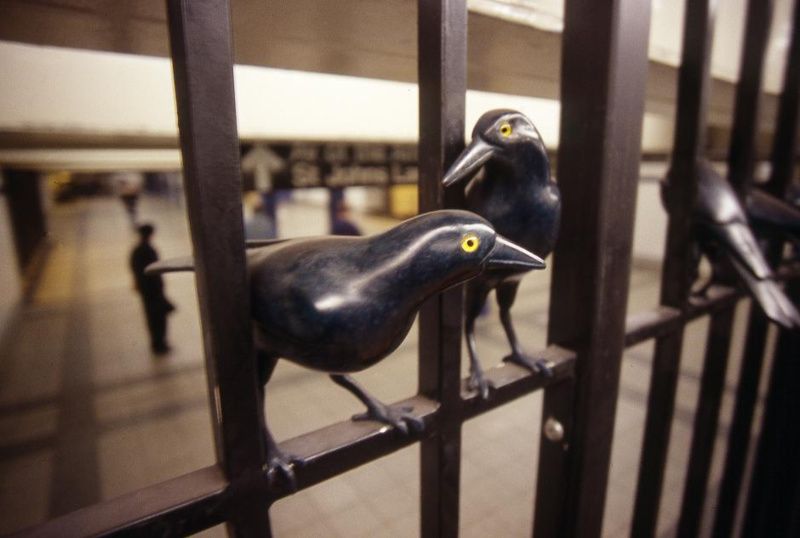
Scattered throughout the Canal Street station are dozens of birds, 174 grackles and blackbirds to be exact. While live birds may be seen as well, these are all cast in bronze and given a glossy black patina. They can be found in dozens of different poses, perching on railings, or watching commuters from beams above.
Birds are very social animals, similar to New Yorkers. Subway riders may find echoes of themselves in these small creatures and their fun expressions. A daily commute may be boring, especially if the station is commercial and devoid of nature. Artists Walter Martin and Paloma Muñoz created the creatures to enliven the space and bring a smile to New Yorkers’ faces.
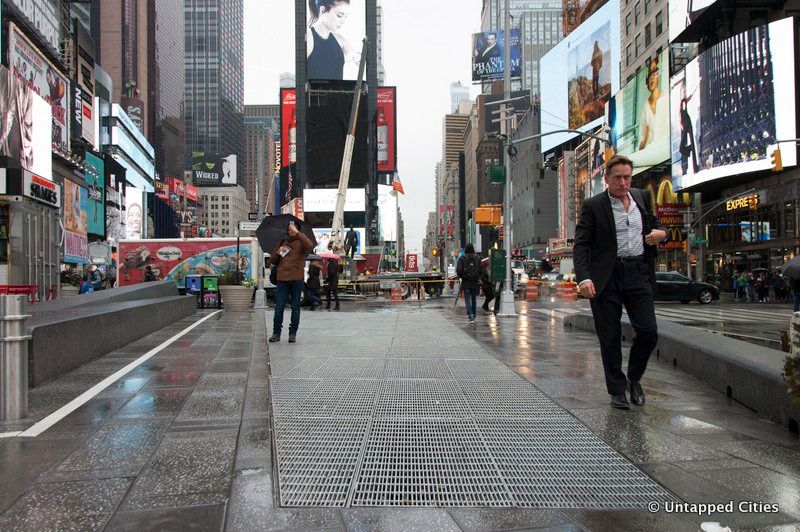
This above-ground subway art piece was created in 1977 by percussionist, artist, and “sound sculptor” Max Neuhaus. Despite its very public location in the heart of Times Square, you might not realize it’s anything more than your average subway grate until you stand above it.
Neuhaus constructed homemade electronic sound generators which are installed inside the steam escape shaft below the grate on the sidewalk between Broadway and 7th along with a loudspeaker. While powering the work was troublesome due to the high voltage, Neuhaus was committed to making sure his creation could run. The piece functioned from 1977 to the early 90s, with gallery owner Christine Burgin set on bringing the installation back in 2002. It was soon relaunched with a higher volume to combat the increased noise in the area. Walk across it next time you’re in the area for a unique sonic experience!
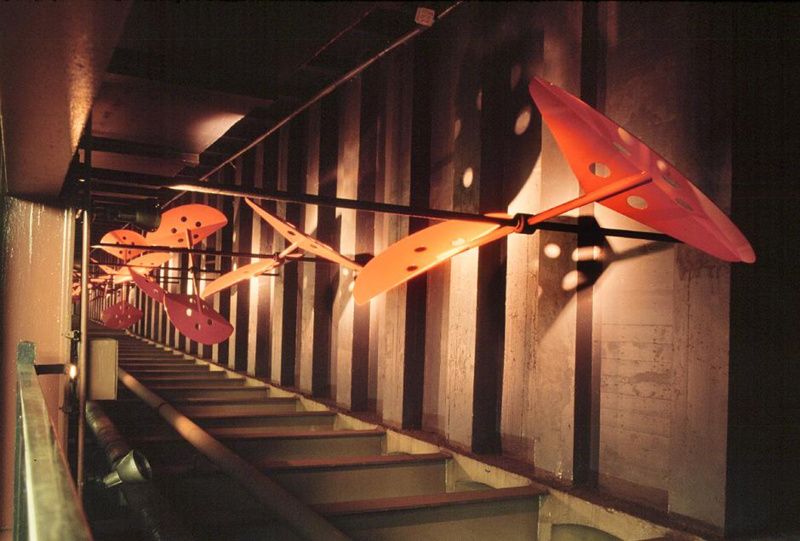
This incredibly easy to miss installation was created by artist David Provan, known for his abstract sculptures, in 1992. It consists of a series of red wind paddles hanging against the east wall of the station. Provan’s idea was that each 12-inch paddle would delicately turn and flutter due to the wind generated by departing and approaching trains. The paddles may mimic commuters’ hair flying while their train pulls into the station. The varying amounts of wind would send the bright paddles floating and tilting, becoming an entertaining hidden find for passersby. Today, the once vibrantly colored pieces are quite dirty and could use a good cleaning!

It’s easy to pass underneath these floating spheres and never notice them. This installation, titled Halo, was created by Long Island-born artist Nicholas Pearson in 1991. The ethereal orbs are made out of coiled aluminum rods. They seemingly hover above the crowds below, suspended on a framework of small beams attached to the larger steel structure of the station. The artist chose these circular shapes to create a moment of “unexpected certainty” among the sharp rectilinear forms of their setting.

Through a network of frames, windows, mirrors, and apertures, artist Mary Miss highlights the hidden structural cables, conduits, and industrial gems of the Union Square station. During the rehabilitation of the station, old decorative works from the original station reappeared, including many aspects that were considered lost forever. Beautiful mosaics from old New York are held stable by bright red frames, calling back to early visits to the station when red lines were spray painted on walls to note objects in disrepair. Mary Miss aimed to create an inviting atmosphere for the public to see a historical slice of the station, including its history below the surface.

This three-piece art installation is spread throughout Brooklyn’s Atlantic Avenue-Barclays Center station. Artist George Trakas had a specific idea of how to experience it. Taking the D train from Bleecker Street to the Atlantic Avenue stop will prepare the viewer for the narrative of movement that informs the sculpture. Hook is the granite stonework installed along the curved passageway that leads from the Pacific Street entrance to the tracks blow. The wave-shaped granite work on the wall emphasizes the floor’s rolling movement throughout the station. Line is the interior vertical space within the original station kiosk from 1908. It is transformed into a symbolic skylight that houses a giant steel sculptor reminiscent of a boat. Sinker is the name of the incline made out of granite blocks, following the stairs and platforms of the station. This piece was the perfect opportunity for a collaboration between artist and architect, unifying the passageways and stairways of the station to create a coherent space.
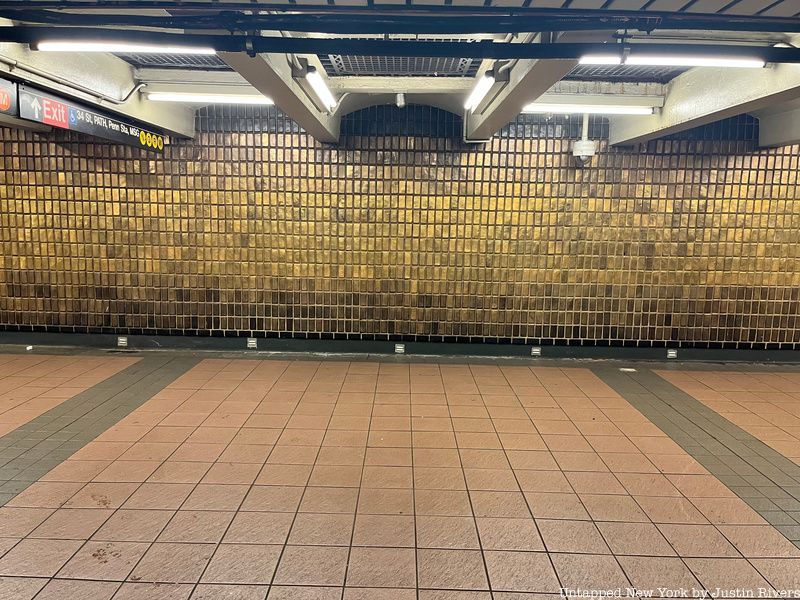
The glimmering gold tiles of this gold wall may seem like a simple design choice for the station, but its backstory is fascinating. In 1991, artist Michele Oka Doner was given creative freedom to transform this 165-foot-long wall of dead space. Perplexed as to what she could make of it, she thought about the thousands of people coming and going at the station. The low ceiling and long walls create a dark atmosphere, and so her idea was to bring brightness underground. Using 11,000 tiles painted in varying degrees of gold, Oka Doner created a horizon at the 34th Street-Herald Square Station.
Next time you’re making your morning or afternoon commute, take a second to look around at the beams and tracks around you; you may find your new favorite art piece!
Next, check out 7 Examples of Abandoned Subway Art
Subscribe to our newsletter